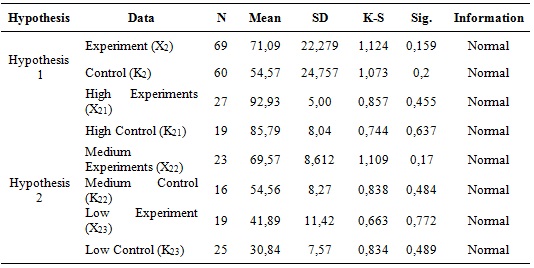
The Effect of SSCS Learning Model on the Mathematical Problem Solving Ability of Junior High School Students, Kampar Regency
Abstract
Keywords
Full Text:
PDFReferences
Akdon & Riduwan. (2010). Rumus dan Data Dalam Analisis Statistik. Cet 2. Alfabeta.
Ayu, Y. (2016). Analisis Kemampuan Pemecahan Masalah Matematis Siswa Kelas Xi Mipa Sma Negeri 1 Kota Jambi. Jurnal Ilmiah DIKDAYA, 6(2), 12–19.
Bernard, M., Nurmala, N., Mariam, S., & Rustyani, N. (2018). Analisis Kemampuan Pemecahan Masalah Matematis Siswa SMP Kelas IX Pada Materi Bangun Datar. SJME (Supremum Journal of Mathematics Education), 2(2), 77-83.
Chen, W. H. (2013). Applying problem-based learning model and creative design to conic-sections teaching. International Journal of Education and Information Technologies, 3(7), 73-80.
Heleni, S., & Zulkarnain. (2018). The Influence of Mathematical Thinking Ability with Modified MOORE Method on Learning Outcomes of Basic Mathematic II Chemical Education Students. Journal of EducationalSciences, 2(2), 33-41.
Hobri, Ummah, I. K., Yuliati, N., & Dafik (2020). The Effect of Jumping Task Based on Creative Problem Solving on Students’ Problem Solving Ability. International Journal of Instruction,13(1), 387-406.
Irwan., 2011. Pengaruh Pendekatan Problem Posing Model Search Solve Create and Share dalam Upaya Meningkatkan Kemampuan Penalaran Matematis Mahasiswa Matematika. Jurnal Penelitian Pendidikan, 12(1).
Rizki, K.S.R., & Wijayanti, P. (2013). Penerapan Model Pembelajaran Probelm Solving Search, Solve , Create , And Share Pada Materi Aljabar Di Kelas VIII SMP Negeri 22 Surabaya. MATHEdunesa, 2(1).
Kurniati, D., Harimukti, R., & Jamil, N. A. (2016). Kemampuan Berpikir Tingkat Tinggi Siswa Smp Di Kabupaten Jember Dalam Menyelesaikan Soal Berstandar Pisa. Jurnal Penelitian Dan Evaluasi Pendidikan, 20(2), 142. https://doi.org/10.21831/pep.v20i2.8058
NCTM. (2000). Executive Summary Principles and Standars for School Mathematics.
Ningsih, E. F. (2019). Implementasi Model Pembelajaran Search, Solve, Create and Share (SSCS) untuk Meningkatkan Kemampuan Berpikir Kreatif Matematis. GAUSS: Jurnal Pendidikan Matematika, 2(1), 25-34.
Ningsih, F., Murni, A. & Roza, Y. (2020). Development of Learning Tools with the Application of Learning Inventions to Improve Mathematical Problem Solving Ability Social Arithmetic Material. Journal of Educational Sciences, 4(1), 44-52.
Purbaningrum, K. A. (2017). Kemampuan berpikir tingkat tinggi siswa smp dalam pemecahan masalah matematika ditinjau dari gaya belajar. Jurnal Penelitian Dan Pendidikan Matematika, 10(2), 40–49.
Rahmawati, N. T., Junaedi, I., & Kurniasih, A. W. (2013). Keefektifan Model Pembelajaran Sscs Berbantuan Kartu Masalah Terhadap Kemampuan Pemecahan Masalah Siswa Info Artikel Abstra, 2(3).
Rianti, R., Saragih, S. & Zulkarnain. (2020). Development of Mathematics Learning Tools in the Context of Riau Malay Culture to Improve Students' Mathematical Problem Solving Ability. Journal of Educational Sciences, 4(1), 73-82.
Sugiyono. (2011). Metode Penelitian Pendidikan. Bandung: Alfabeta
Sumartini, T. S., 2016. Peningkatan Kemampuan Pemecahan Masalah Matematis Siswa melalui Pembelajaran Berbasis Masalah. Mosharafa Jurnal Pendidikan Matematika, 5, 148-158.
Ulya, H. (2016). Profil Kemampuan Pemecahan Masalah Siswa Bermotivasi Belajar Tinggi Berdasarkan Ideal Problem Solving. Jurnal Konseling GUSJIGANG, 2(1), 90–96.
DOI: http://dx.doi.org/10.31258/jes.4.2.p.309-317
Refbacks
- There are currently no refbacks.
Copyright (c) 2020 Muhammad Syafri, Zulkarnain Zulkarnain, Maimunah Maimunah

This work is licensed under a Creative Commons Attribution 4.0 International License.
Publisher: FKIP Universitas Riau












